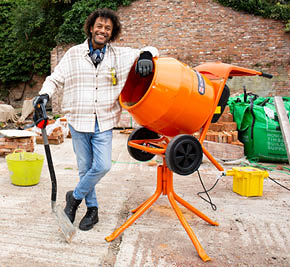
Cement Mixer Buying Guide
Cement mixers are common pieces of equipment on building sites across the UK, as well as in gardens during renovations.
They’re essential for any job involving the mixing of concrete and mortar. Mixing concrete by hand can be exhausting and an ineffective use of time. There are so many to choose from, and you have to consider their size, power source, and portability.
As you only need them for specific projects or one-off jobs, hiring a cement mixer can be more economical than purchasing a cement mixer. This way, you don’t need to store them or sell them after use.
Whether buying or hiring your cement mixer, below is everything you need to look out for, and the differences between models.
How to choose a cement mixer
Cement mixers blend aggregate with cement and water to make concrete or mortar. They fully mix and combine the materials to ensure it is perfect to use.
If you’re working on a site, take a look at our range of site mixers, which are heavy-duty and suitable for constant use.
For DIY and home use, or work on a smaller scale, a tip-up cement mixer will be easier to handle, as they’re lighter weight and more portable. When done, simply tip the mixer and pour the cement into a wheelbarrow.
Our cement mixer bundle is a great option for small and medium projects, as you get the extension lead, stand, and transformer all in one.
Hire Speedy’s Cement Mixer Bundle
When using a cement mixer, always wear long sleeves and trousers, as well as PPE (safety boots, eye protection, and work gloves). All PPE and protective clothing can be purchased from Speedy.
1. Volume/Drum capacity
The volume of concrete or cement you need is the most important thing. There is a difference between drum volume and mixing volume though.
The mixing capacity of a cement mixer drum is around 80% of the total capacity. So, a 100-litre drum will be able to mix 80 litres of cement.
Overfilling the drum means the cement won’t mix completely and uniformly. Underfilling the drum will cause the cement to stick to the drum walls and not mix.
If you hire a mixer which is too large, you’ll make too much product, and some will be wasted. Too small, and you’ll have to increase the number of loads you make, which is time-consuming.
2. Power source
Cement mixers can be electric or petrol. The latter is most popular on construction sites, where electrical power is hard to come by, and more power is required.
However, petrol-powered mixers are heavier, bulkier, and more polluting (atmospheric and noise). So, they’re not always ideal for residential or home use.
Electric cement mixers are becoming more popular, as they’re greener. They can work with generators if you’re remote and are often lighter and quieter than their petrol counterparts.
Electric mixers are also generally more lightweight and easier to manoeuvre, so as long as you have a power source available, this may be the best option.
3. Mixer type
Now we are getting into the more technical components of a cement mixer. There are three types of mixers: planetary, drum, and continuous feed.
- Planetary mixers are often the cheapest solution
- Rotating drum mixers are more expensive, but faster at the job
- Continuous feed mixers allow for continuous mixing rather than having to wait for a batch to finish and start again, which saves time on big jobs.
IS THERE CEMENT MIXER HIRE NEAR ME?
Yes. Speedy Hire, the UK's leading tool hire company, have a range of cement mixers and accessories for hire nationwide.
Speedy has more than 200 local service centres across the nation, hire counters in selected B&Qs and nationwide 4-hour delivery available on many of our mixers, too. It has never been easier to hire the tools and equipment you need.
You’ll find all the tools you need right here. Why not open a Speedy account today online or visit us in your local depot to start hiring today?
- 2024
- 2023
- December 2023 (13)
- November 2023 (9)
- October 2023 (7)
- September 2023 (10)
- August 2023 (20)
- July 2023 (21)
- June 2023 (17)
- May 2023 (17)
- April 2023 (16)
- March 2023 (14)
- February 2023 (15)
- January 2023 (7)
- 2022
- December 2022 (6)
- November 2022 (12)
- October 2022 (24)
- September 2022 (14)
- August 2022 (12)
- July 2022 (15)
- June 2022 (18)
- May 2022 (14)
- April 2022 (9)
- March 2022 (5)
- February 2022 (5)
- January 2022 (2)
- 2021
- December 2021 (7)
- November 2021 (10)
- October 2021 (1)
- September 2021 (1)
- August 2021 (3)
- July 2021 (3)
- June 2021 (4)
- May 2021 (1)
- April 2021 (1)
- March 2021 (2)
- February 2021 (1)
- January 2021 (1)
- 2020
- 2019
- 2017
- 2016
- 2014
- 2013
- 2012
- 2011


